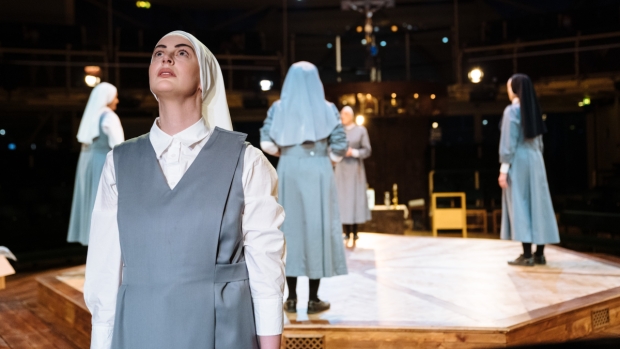Electric Rosary at Royal Exchange Theatre – review

© Helen Murray
If you've been waiting for a play of bravura, originality and ambition, your prayers have been answered. Tim Foley's Bruntwood Prize-winning play fuses religion with robotics, and you'd need more than artificial intelligence to infer it's Foley's main stage debut from its knottiness and daring plot. But if you're looking for one that marshalls its conviction and imagination into a cogent piece, you'll need to keep clutching your rosary beads.
The chapel room we're introduced to impresses modesty rather than grandeur – relics packaged into shabby boxes, on a set of plain, muted wood. These nuns' funds need a miracle. Hail Mary: a council-funded robot which injects the convent's coffers with a bursary. But the bareness also exposes the cultural conflicts within a convent who decode text messages as you might parse holy scripture – an altar sits next to a laptop and projector, while a crucifix looms above. When Mary arrives, she soon notices it and seems to identify with it – resembling its fixed, stiff posture, eventually even emulating its pose.
Her non-synthetic sisters meet her "hunk of metal" when they come in from the mud and rain. Foley constantly shows such contradictions to reflect the binaries in a religion structured on sin and sanctity but which hypocritically shuns Mary for being programmed in comparable clear-cut distinctions. Likewise, their desperation to reach a pilgrimage in Ecuador for its elevating spiritual rejuvenation becomes mired in financial-obsessed pragmatism. A rising faction of "luddites" lurking outside the convent walls co-opt religious rhetoric of "the day of reckoning" to rationalise a violent, merciless revolution.
By making the council's bureaucracy bionic, Foley articulates anxieties around robots replacing jobs. It appears the logical progression of a time when we rely on devices of all sorts to sustain our lives, contain our thoughts and facilitate our connections. He asks whether our most essential questions can become automated – whether steel can know and nourish our soul.
None of it would be so interesting if the nuns weren't themselves. Mary is used to draw parallels with the robotic life of a nun: their routines of prayer, domestic chores and fundraising; their position as cogs in the service of a vast machine. When they sing in chorus to Anna Clock's organ music, their echoing voices reverberate with loneliness. Jaz Woodcock-Stewart's direction cleverly brings out these emotional stakes, accentuating their isolation by creating gaping space on the stage, so they're always mirroring the single photo of their dead superior on the altar. Foley's script stresses their solitude through the repeated "one": their oxymoronic "we are one" is gradually replaced by "I am no one" as a marker of humanity sinks into a quietly resigned acceptance.
It's made more affecting by a countervailing maternal-sisterly dynamic. Saroja-Lily Ratnavel plays the ingenuous younger Theresa, while Olwen May and Jo Mousley jostle for the Mother position like parents. May imbues Constance with a deeper, weightier cadence, disciplinarian in her belief that mercy and machines don't match. She intricately metabolises her loss of faith as though it literally leaves her body, carrying herself lower the more doubt creeps in and drains her out.
Just as these actors keep the nuns away from caricature, so does Breffni Holahan as Mary. She begins with the robot hallmarks: arms kept straightened down the sides, a head which swivels on a pivot as it tracks, and a monotone delivery with flat intonation and stilted rhythm. But it's in the canvas of human emotion – the face – where there's the most to read. Her eyes expand and contract like a focusing camera lens. As her eyes widen with wonder and her face locks in a smile, she appears full of the benevolence seeping out of her sisters.
The play loses this focus and detail in its second half, reaching for grand questions with too broad a sweep. A secondary context it barely sets up in the first half rips through, exploding themes of civility and humanity into a civil war in which Mary functions as some sort of Messianic prophet. Her latent humanity is increasingly overtly shown and her initially ambiguous visions – ironically dismissed by the nuns as malfunctioning glitches – are also given too much explanation.
But it's so full of awe and surprises. At the end, a chain of shapes and colours unfurls from the floor so, out of nowhere, otherworldly prayer beads tower before us. Its adventurous, bold storytelling is the kind of stuff you have to put your hands together for.










